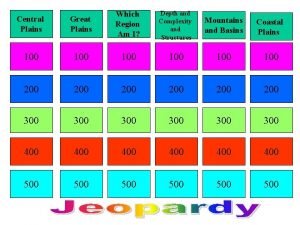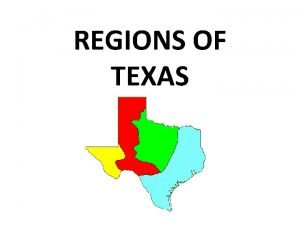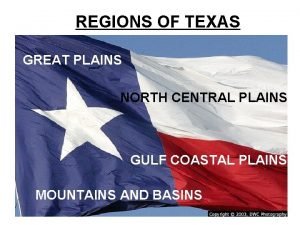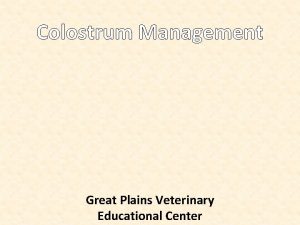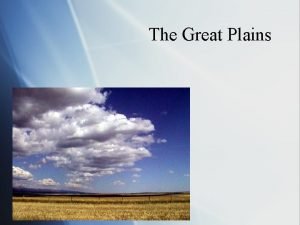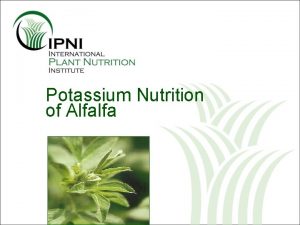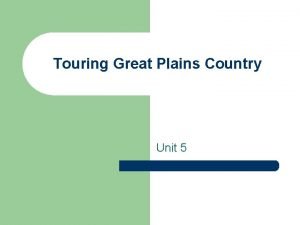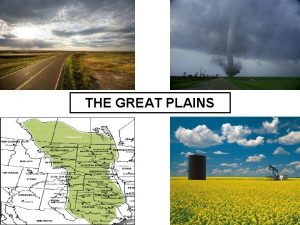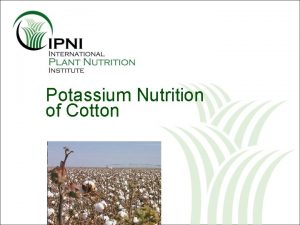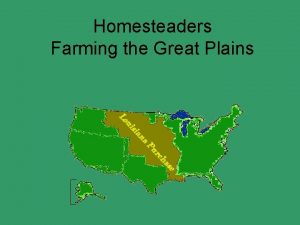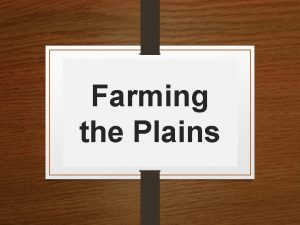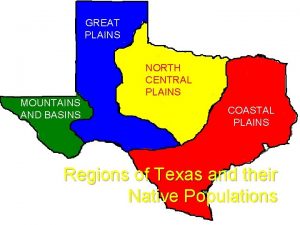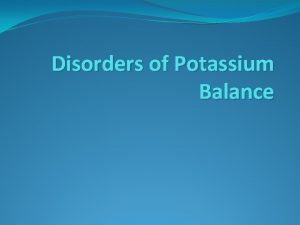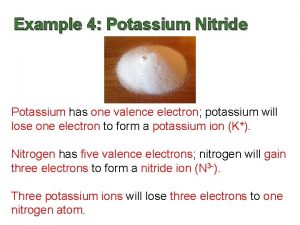Potassium Nutrition in the Northern Great Plains Outline











































- Slides: 43

Potassium Nutrition in the Northern Great Plains

Outline: Potassium (K) Nutrition in the Northern Great Plains • • Role of K in crop production Soil K and soil test levels Crop uptake of K K deficiencies Crop responses to K Chloride (Cl) response Fertilizer K Photo courtesy of Lyle Cowell, SWP

What Is the Role of K in Plants? • K activates enzyme reactions • K controls water uptake and transpiration • K influences energy production in photosynthesis and respiration • K supports photosynthate transport • K fosters nitrate-nitrogen (N) uptake and protein synthesis • K is required for starch synthesis in seeds

Soil K Unavailable (90 to 98%) K K Soil Minerals (feldspar, mica) K K+ K+ Soil Water K+ K+ Readily available (0. 1 to 2%) K+ K+ Soil Colloid Trapped K Soil Colloid K+ K+ Slowly available (1 to 10%)

Soil Testing Methods for K • Most soil tests for K are based on either an ammonium acetate extraction or a similar extraction • In some regions with low CEC soils, K rates are often based on the ratio of K relative to other bases, such as Ca and Mg • Ion exchange membranes which measure the soil supply rate of K

Median Ammonium Acetate Equivalent Soil Test K Levels, 2005

Median Ammonium Acetate Equivalent Soil Test K Levels, 2005 AB SK 201 MB 254 207 MT 259 ND 265 North American-wide 154 ppm 2005

K Deficient Areas on Canadian Prairies May be deficient in K May need K for irrigated crops

Potassium Soil Test Rating and Recommendations - Soil test recommendations vary among labs. - Most labs use a set of regional crop response data to develop fertilizer recommendations based on a K soil test. An example: Wheat K 2 O recommendations using band application (Agvise Labs) Yield bu/A Soil test K, ppm 0 -40 41 -80 81 -120 121 -160 161 -200 201 -250 251 -750 +750 Fertilizer K recommendation, lb K 2 O/A 30 35 30 20 10 10 0 40 50 40 30 15 10 10 10 0 50 65 50 35 20 10 10 10 0 60 75 60 40 25 10 10 10 0 70 90 70 50 30 10 10 10 0

What Are the K Requirements of Crops throughout the Season? Photo courtesy of Lyle Cowell

K Uptake of Wheat During the Growing Season Jacobsen et al. , 1992 (graphic from Korb et al. , 2002)

Crop Uptake of K K uptake in Crop Yield/A total crop, lb K 2 O/A Wheat 40 bu 80 (19)* Canola 35 bu 89 (20) Peas 50 bu 150 (39) Barley silage 4. 5 tons 132 Alfalfa 3 tons 180 *K removed in grain in parenthesis.

Potassium Deficiency Symptoms in Barley grain yield, bu/A 58 60 49 50 38 40 30 20 11 10 0 0 60 120 240 K 2 O rate in lb/A

Potassium Budget in the Northern Great Plains Region, 2000 -2001 State or Province Crop Removal Fertilizer Applied Recoverable Manure (R) (F) (M) Balance F-R F+M-R ----------- K 2 O, million lb ----------Alberta 607 128 136 -479 -343 Saskatchewan 640 59 43 -581 -538 Manitoba 332 92 45 -240 -195 Montana 352 42 9 -310 -301 North Dakota 609 52 13 -557 -544

K Deficiency Symptoms

K Deficiency Symptoms

Plant Tissue K Guidelines for Crops … An Example % K in plant tissue Crop type -- stage Deficient Low Sufficient High Wheat – tillering <1. 2 1. 3 – 1. 5 1. 6 – 3. 0 3. 1 – 9. 9 Wheat – boot <1. 4 1. 5 – 1. 9 2. 0 – 2. 4 2. 5 – 3. 5 Wheat – heading <1. 2 1. 3 – 1. 5 1. 6 – 3. 0 3. 1 – 9. 9 Alfalfa – top 6 in. <1. 7 1. 8 – 2. 4 2. 5 – 3. 8 3. 9 – 4. 7 Agvise Labs

Crop Responses to K • While many northern Great Plains soils have abundant K, the region also has areas with very low soil K • It is not uncommon to find areas of Saskatchewan and Alberta with soils testing 30 to 50 ppm K/A • Crops respond to K application in these low K soils

Barley Response to Soil K Levels and Fertilizer K 2 O % Grain Yield Increase 80 Soil K 25 -50 ppm/A 70 60 50 40 Soil K 50 -75 ppm/A 30 Soil K 75 -100 ppm/A 20 10 0 0 12 24 Added K, lbs K 2 O/A added to seed row N and P added to soil test recommendation D. Walker, Lacombe, AB

Barley, Wheat, and Canola Response to K 70 Grain yield, bu/A 60 Barley 50 40 72 ppm K/A 33 ppm K/A 30 20 Canola 50 ppm K/A Wheat 36 ppm K/A 30 ppm K/A 10 0 0 100 200 400 Added K (lb K 2 O/A Broadcast + Incorp) N and P added to soil test recommendation Henry and Halstead, 1968

K Benefits Crop Growth and Yield Longevity of Alfalfa Stands • K increases carbohydrate in the crown roots of alfalfa during fall growth to increase - Winter hardiness - Early spring re-growth

K Helps Reduce Winterkill in Alfalfa Manitoba - Soil K 116 ppm/A (0 to 6 in. ) Stand density, % 100 No K 100 lb K 2 O/yr 80 60 40 20 0 Year 1 Year 2 Year 3 Year 4 Year 5 Year 6 Year 7 Plant counts in May as % of those the previous September

Crop Response on High K Soils • Yield increases often occur from potash applied on soils not deficient in K. Why? • K responses as a result of: - Cold soils in the spring (slow root growth and nutrient uptake) - Dry soils (droughty conditions reduce K diffusion) - Field (landscape) variability - Cl ion (Cl-) response

Barley Response to Starter K and Seeding Date 7 bu Barley Yield (bu/A) 60 50 6 bu 40 3 bu Check 20 K 2 O 30 20 10 0 April 6 Soil K levels - High May 6 June 3 Dubbs, Montana State Univ.

Crop Response to Added K in High K Soils in Montana (264 Sites) Frequency of response, % 0 20 Winter Wheat 97 Expts. Spring Wheat 33 Expts Feed Barley 48 Expts. 40 60 5. 5 bu/A 4. 8 bu/A 3. 9 bu/A 9. 2 bu/A Malt Barley (irr. ) 10 Expts. Alfalfa Corn Silage Potatoes (irr. ) 36 Expts. 22 Expts. 18 Expts. 80 0. 35 t/A 2. 8 t/A 25 cwt/A Each crop represents 2 to 8 cropping years Soils testing > 600 ppm (1967 -1979) Skogley & Haby 1981

Crop Response to Added K in Alberta (548 sites) Exch. K Total ppm/A 0 - 50 51 - 100 101 - 150 151 - 200 201 - 300 301 - 400 > 400 28 Responsive sites, % 37 70 132 73 115 55 100 52 99 46 37 43 21 1. 9 Average Resp. , cwt/A 6. 1 4. 8 2. 5 2. 4 2. 7 2. 4 Barley, oats, and rape – 1968 -74 Lopetinsky 1977

Frequency (%) Frequency Distribution of Soil K on a 220 x 220 ft. Grid at Mundare, AB 35 30 25 20 15 10 5 0 Mean = 135 ppm Mode = 108 ppm 59 -101 101143 143185 185227 Soil K (ppm) Penny et al. , 1996 227269 269311

Chloride---An Essential Plant Nutrient • The deficiency of Cl in the soil can account for crop responses to KCl application. • Earliest report of Cl crop response. . . table salt (Na. Cl) in mid 1800 s • Recognized as an essential micronutrient since the 1950 s • Research in the late 1970 s revealed insufficient levels in many areas

Crop Responses to Chloride • Chloride has been shown to have an effect on: – Root rot and foliar diseases in cereal crops – Seed weight at harvest, especially barley, by extending the grain filling period – Reducing physiological leaf spot in cereal crops on fields where soil Cl is less than 10 lb/A (24 in. depth) – Increasing crop yields

Physiological Leaf Spot on Kestrel Winter Wheat No Chloride

Chloride May Improve Crop Yields • ~ 200 university trials in KS, MN, MT, ND, SD, MB, and SK have evaluated Cl response in wheat and barley – Included non-responsive and high Cl sites • Significant yield response in 48% of trials • Average yield response of 5 bu/A

Yield Boost from Chloride Depends on Wheat Variety Yield response, bu/A 12 1996 10 1997 1998 8 6 4 2 0 -2 -4 -6 Barrie Cora Grandin Karma Kyle

Fertilizer K Management

Once in the soil, all fertilizer sources are the same form as found in the soil (K+). This is the form taken up by plants. + K KCl K 2 SO 4

What Happens to Fertilizer K in the Soil? • Absorbed by crop in year 1: – 20 to 60% of applied K – Highest recovery on low K soils • Slowly available K (future years): – Bulk of remaining K in most soil types – Future supply of K Available K Slowly Available K Unavailable K

Fertilizer K Sources Source Analysis Potassium chloride, KCl 0 -0 -60 (62) Potassium sulfate, K 2 SO 4 0 -0 -50 - 17 Potassium nitrate, KNO 3 13 -0 -44 Potassium-magnesium sulfate, K 2 SO 4. 2 Mg. SO 4 0 -0 -22 -22 -11 Potassium thiosulfate, K 2 S 2 O 3 0 -0 -25 -17

Fertilizer K Placement

Grain Yield Increase (bu/A) Barley Response to KCl Placement and Rate 30 Seed row 25 Side band 20 Broadcast 15 10 5 0 0 15 30 60 90 120 150 180 240 lb K 2 O/A N and P added to soil test recommendation SIP Soil Fertility Rpt, 1968

Safe Rates of Seed Row K application (Saskatchewan) • Seed row application of K 2 O should not exceed (1 in. spread, 6 to 7 in. rows): – Cereals – 50 lb K 2 O/A – Canola – 20 lb K 2 O/A – Dry pea – 15 lb K 2 O/A • Combined P 2 O 5 and K 2 O in the seed row should also not exceed the recommended safe rates for K 2 O alone Source: Saskatchewan Agriculture and Food

• Split-root experiment • Percent of the total root system on the side with K was the same as that on the side without K • Effects of K on root growth may not be localized as is found with P Proportion of roots observed in K solution (%) Potassium Does Not Cause Roots to Proliferate 100 Corn 17 days old 80 60 40 20 0 0 20 40 60 80 Proportion of roots expected for no K effect (%) Classen and Barber, 1977 100

Be Sure and Use Soil Testing to Monitor Soil K Supplies

Summary— K Nutrition in the Northern Great Plains • K nutrition is critical to crop production • Most northern Great Plains soils are high in K, allowing for a net removal of soil K each year • Crops take up as much K as N during growth, with only a small proportion removed in grain • Where deficient, crop response to K is greatest for barley, followed by wheat and canola • Crop responses to muriate of potash (KCl) can be a Cl response

International Plant Nutrition Institute 655 Engineering Drive, Suite 110 Norcross, GA 30092 -2604 Phone: 770 -447 -0335; Fax: 770 -448 -0439 www. ipni. net Reference #06111
 Central plains center of amarillo, tx
Central plains center of amarillo, tx Three sections of northern plains
Three sections of northern plains Geographic regions of texas
Geographic regions of texas Mountains and basins important cities
Mountains and basins important cities North america east region
North america east region Microsoft business solutions great plains
Microsoft business solutions great plains Great plains ada center
Great plains ada center Edwards plateau landforms
Edwards plateau landforms Great plains
Great plains Settling on the great plains section 2
Settling on the great plains section 2 Great plains veterinary educational center
Great plains veterinary educational center Great plains westward expansion
Great plains westward expansion What words describe the great plains?
What words describe the great plains? Great plains network
Great plains network Great plains ultra till
Great plains ultra till Quote sandwich paragraph example
Quote sandwich paragraph example The great depression outline
The great depression outline Hình ảnh bộ gõ cơ thể búng tay
Hình ảnh bộ gõ cơ thể búng tay Slidetodoc
Slidetodoc Bổ thể
Bổ thể Tỉ lệ cơ thể trẻ em
Tỉ lệ cơ thể trẻ em Chó sói
Chó sói Thang điểm glasgow
Thang điểm glasgow Alleluia hat len nguoi oi
Alleluia hat len nguoi oi Môn thể thao bắt đầu bằng từ chạy
Môn thể thao bắt đầu bằng từ chạy Thế nào là hệ số cao nhất
Thế nào là hệ số cao nhất Các châu lục và đại dương trên thế giới
Các châu lục và đại dương trên thế giới Công thức tính thế năng
Công thức tính thế năng Trời xanh đây là của chúng ta thể thơ
Trời xanh đây là của chúng ta thể thơ Mật thư anh em như thể tay chân
Mật thư anh em như thể tay chân Làm thế nào để 102-1=99
Làm thế nào để 102-1=99 độ dài liên kết
độ dài liên kết Các châu lục và đại dương trên thế giới
Các châu lục và đại dương trên thế giới Thơ thất ngôn tứ tuyệt đường luật
Thơ thất ngôn tứ tuyệt đường luật Quá trình desamine hóa có thể tạo ra
Quá trình desamine hóa có thể tạo ra Một số thể thơ truyền thống
Một số thể thơ truyền thống Cái miệng nó xinh thế chỉ nói điều hay thôi
Cái miệng nó xinh thế chỉ nói điều hay thôi Vẽ hình chiếu vuông góc của vật thể sau
Vẽ hình chiếu vuông góc của vật thể sau Nguyên nhân của sự mỏi cơ sinh 8
Nguyên nhân của sự mỏi cơ sinh 8 đặc điểm cơ thể của người tối cổ
đặc điểm cơ thể của người tối cổ Giọng cùng tên là
Giọng cùng tên là Vẽ hình chiếu đứng bằng cạnh của vật thể
Vẽ hình chiếu đứng bằng cạnh của vật thể Vẽ hình chiếu vuông góc của vật thể sau
Vẽ hình chiếu vuông góc của vật thể sau Thẻ vin
Thẻ vin
